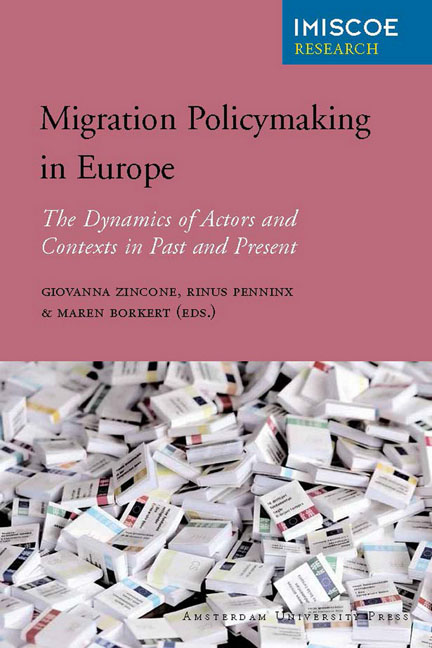Book contents
- Frontmatter
- Contents
- Policymaking in the Field of Migration and Integration in Europe: An Introduction
- Part I Post-War Migration Countries
- Part II Mediterranean Migration Countries
- Part III Eastern European Countries
- Conclusion: Comparing the Making of Migration Policies
- List of Contributors
- Other IMISCOE Titles
10 - The Case of Poland
Published online by Cambridge University Press: 20 January 2021
- Frontmatter
- Contents
- Policymaking in the Field of Migration and Integration in Europe: An Introduction
- Part I Post-War Migration Countries
- Part II Mediterranean Migration Countries
- Part III Eastern European Countries
- Conclusion: Comparing the Making of Migration Policies
- List of Contributors
- Other IMISCOE Titles
Summary
Introduction
The Cold War's division of Europe impacted forms and directions of migratory movements on the continent. For both ideological and economic reasons, Poland was excluded from the modernisation process that occasioned mass immigration to Europe starting in the 1960s. As a result, the country did not experience rapid inflows; nor did it experience its consequences, such as the politicisation of migration issues.
After the collapse of Communism and the dismantling of the whole Soviet Bloc, a rapid process of transformation started in Central European countries, affecting the majority of political and economic spheres of life. The highly developed countries of Western Europe emerged as a primary reference point for the changes. Many institutions and measures designed in the West in response to the immigration phenomenon were transposed to Poland during the process of harmonisation with the EU. This led to a paradox: attempting to create migration policy before there was a real need for it, in terms of immigrant numbers.
That Poland needed a proactive migration policy (see Iglicka 2003) was actually a view transferred from the West along with other migration-related concepts. The opinion soon gathered much support, mainly among NGOs and within some academic circles. As such, examples based on experiences of Western countries have often been the only legitimising argument in favour of the policy changes postulated by migration experts.
At the same time, institutions facilitating or blocking emigration had existed in Poland since its reestablishment in 1918. This element of migration policy ‘officially’ disappeared from migration policy discourse as well as highly publicised government initiatives after 1989. This runs counter to the fact that it is emigration – not immigration – that should be an issue in Polish migration policy, given the discrepancies in the scale of the country's outflows and inflows. It was only the huge post-accession outflow that brought emigration back into the political and public debates.
A history of migration: From sole emigration to emigration and immigration
Until recently, migratory flows in Poland have predominantly concerned the outflow of Polish nationals. Politically motivated emigration dates back to the end of the eighteenth century when waves of political refugees left Poland due to the country's partition, followed by uprisings for independence carried over into the nineteenth century.
- Type
- Chapter
- Information
- Migration Policymaking in EuropeThe Dynamics of Actors and Contexts in Past and Present, pp. 347 - 376Publisher: Amsterdam University PressPrint publication year: 2012
- 2
- Cited by



